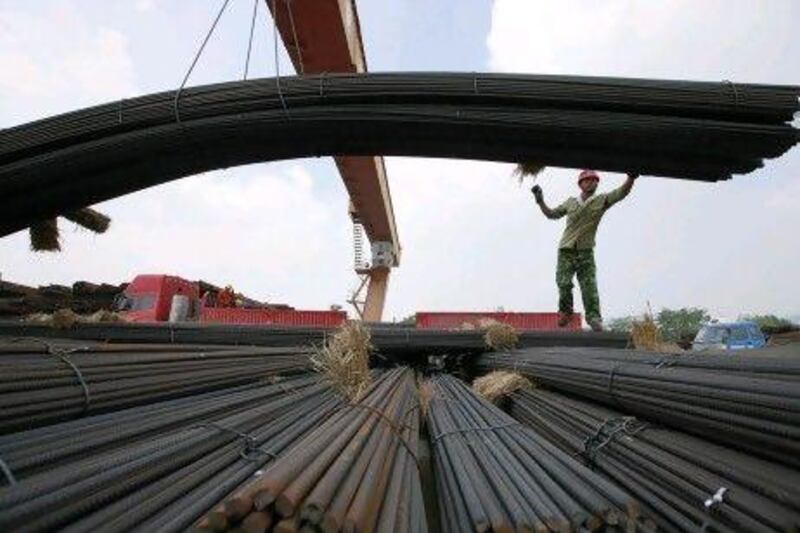BEIJING // Chinese policymakers were dealt fresh blows as trade and new bank lending suggested pro-growth policies have been slow to gain traction and more urgent action may be needed to stabilise the economy.
Figures yesterday showed exports last month rose just 1 per cent from a year ago and that new loans were at a 10-month low.
On Thursday, figures showed factory output rising at its lowest pace in three years.
The first hard data of the third quarter has led some analysts to question the strength of what was expected to be the start of a shallow rebound in the economy after growth had slipped for six successive quarters.
Some economists say the central bank could move as early as this weekend to ease policy. It has reduced banks' required reserve ratio in three steps since November to free up an estimated 1.2 trillion yuan (Dh692.86 billion) for new lending and cut interest rates in June and last month.
Furthermore, net new bank lending last month of just 540bn yuan, against expectations of 690bn yuan, is a big potential cause of concern. Bank loans are the main credit creation mechanism in the economy, which is only in the early stages of reforming capital markets to boost available sources of corporate finance.
The low figure adds to fear of faltering demand from China's two biggest customers - the European Union and the United States.
Excluding a fall in exports in January, the 1 per cent rise last month is the weakest since November 2009 and marked a big pullback from annual growth in June of more than 11 per cent, Reuters data shows. Shipments to the EU dropped more than 16 per cent.
Imports last month rose 4.7 per cent from a year earlier, the weakest pace since April and also well short of expectations for an increase of 7.2 per cent.
"This complicates the prospects for an imminent recovery. With the export sector losing speed faster than expected, the government's current investment stimulus plan looks woefully inadequate," said Alistair Thornton an economist at IHS Global Insight in Beijing.
China is not alone in feeling the pressure. Taiwan this week posted a fifth straight month of decline in exports in July, dragged down by double-digit drops in shipments to China, Europe and the US, while South Korea's July exports were the worst in nearly three years.
In Hong Kong, the economy shrank 0.1 per cent in the second quarter due to weak exports amid slowing global growth, the government said yesterday.
"On a seasonally adjusted quarter-to-quarter comparison, real GDP dipped marginally by 0.1 per cent in the second quarter, following 0.6 per cent growth in the first quarter," an official statement said. "The negative spillovers from the sluggishness of the advanced economies to Asia have … turned increasingly visible," the Hong Kong government said.
In New York, stock futures declined as further signs of slowing growth in China prompted a pullback, with the Standard & Poor's 500 index poised to snap a five-day streak of gains. Less than an hour before the open, the Dow Jones Industrial Average futures lost 53 points, or 0.4 per cent, to 13,085.
S&P's 500 stock index futures gave up seven points, or 0.5 per cent, to 1,394, and Nasdaq 100 futures fell 10 points, or 0.4 per cent, to 2,708.
Meanwhile, American import prices for last month slipped 0.6 per cent from a month earlier, the labour department reported.
European markets were also broadly lower, with the Stoxx Europe 600 starting yesterday down 0.4 per cent and on track for the first loss in six sessions.
Oil fell the most in six days yesterday, paring its weekly gain. The International Energy Agency (IEA) said demand expansion was slowing. Futures fell as much as 1.6 per cent in New York after the customs bureau in Beijing said yesterday that China's net oil imports had shrunk to the lowest level this year.
The IEA cut global oil demand forecasts for this year and next. "Most of the drop in oil prices today come from macro figures in China," said Thina Saltvedt, an analyst at Nordea Bank in Oslo. "It started with China and then the IEA. That just added to the gloomy picture."
Oil for September delivery dropped as much as $1.47, the most since August 2, to $91.89 a barrel in electronic trading on the New York Mercantile Exchange.
Brent crude for September settlement fell $1.70 to $111.51 a barrel on the London-based ICE Futures Europe exchange after advancing 1 per cent on Thursday. The European benchmark's premium to West Texas Intermediate was $19.59, compared with $19.86 on Thursday, the widest gap since April.
* compiled from Reuters, Bloomberg News and Dow Jones





